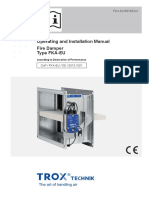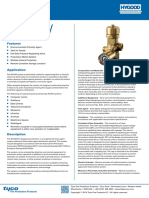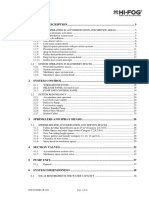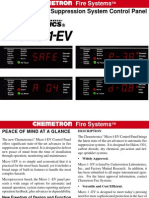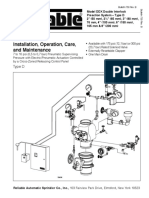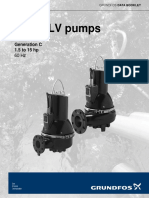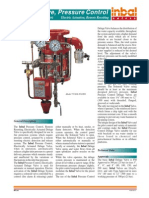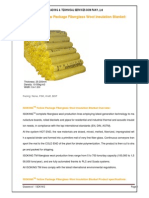0 ratings0% found this document useful (0 votes)
394 viewsInbal - Deluge Valve Pressure Control 03 - 13 CR01
Inbal - Deluge Valve Pressure Control 03 - 13 CR01
Uploaded by
gustavosalvatoThe Inbal pressure Control, Electrically Actuated Deluge Valve is designed for use in fire protection systems which require pressure control, actuated by a Remote Resetting electric detection and release system. When in operation, automatically reduces a higher inlet pressure to a preset delivery pressure which remains steady and unaffected by the variations or fluctuations in the inlet line pressure. While the valve operates, the deluge system pressure is maintained at the preset level within a narrow range.
Copyright:
© All Rights Reserved
Available Formats
Download as PDF, TXT or read online from Scribd
Inbal - Deluge Valve Pressure Control 03 - 13 CR01
Inbal - Deluge Valve Pressure Control 03 - 13 CR01
Uploaded by
gustavosalvato0 ratings0% found this document useful (0 votes)
394 views4 pagesThe Inbal pressure Control, Electrically Actuated Deluge Valve is designed for use in fire protection systems which require pressure control, actuated by a Remote Resetting electric detection and release system. When in operation, automatically reduces a higher inlet pressure to a preset delivery pressure which remains steady and unaffected by the variations or fluctuations in the inlet line pressure. While the valve operates, the deluge system pressure is maintained at the preset level within a narrow range.
Original Title
Inbal - Deluge Valve Pressure Control 03_13 CR01
Copyright
© © All Rights Reserved
Available Formats
PDF, TXT or read online from Scribd
Share this document
Did you find this document useful?
Is this content inappropriate?
The Inbal pressure Control, Electrically Actuated Deluge Valve is designed for use in fire protection systems which require pressure control, actuated by a Remote Resetting electric detection and release system. When in operation, automatically reduces a higher inlet pressure to a preset delivery pressure which remains steady and unaffected by the variations or fluctuations in the inlet line pressure. While the valve operates, the deluge system pressure is maintained at the preset level within a narrow range.
Copyright:
© All Rights Reserved
Available Formats
Download as PDF, TXT or read online from Scribd
Download as pdf or txt
0 ratings0% found this document useful (0 votes)
394 views4 pagesInbal - Deluge Valve Pressure Control 03 - 13 CR01
Inbal - Deluge Valve Pressure Control 03 - 13 CR01
Uploaded by
gustavosalvatoThe Inbal pressure Control, Electrically Actuated Deluge Valve is designed for use in fire protection systems which require pressure control, actuated by a Remote Resetting electric detection and release system. When in operation, automatically reduces a higher inlet pressure to a preset delivery pressure which remains steady and unaffected by the variations or fluctuations in the inlet line pressure. While the valve operates, the deluge system pressure is maintained at the preset level within a narrow range.
Copyright:
© All Rights Reserved
Available Formats
Download as PDF, TXT or read online from Scribd
Download as pdf or txt
You are on page 1of 4
Model 733DX-03CR01
Deluge Valve, Pressure Control
Electric Actuation, Remote Resetting Series700D/DX - 03/13CR01
F06-04-01
General Description
The Inbal Pressure Control, Remote
Resetting, Electrically Actuated Deluge
Valve is specifically designed for use in
fire protection systems which require
pressure control, actuated by a remote
resetting electric detection and release
system. The Inbal Pressure Control,
Electrically Actuated Deluge Valve,
when in operation, automatically
reduces a higher inlet pressure to a preset
delivery pressure which remains steady
and unaffected by the variations or
fluctuations in the inlet line pressure.
The Inbal Pressure Control, Electrically
Actuated Deluge Valve is used for
automatic or manual operation. Electric
activation of the Inbal Deluge System
requires a solenoid valve controlled by a
control (fire alarm & releasing) panel
either manually or by heat, smoke, or
flame detectors. When the detection
system operates, the control panel
activates the Solenoid Valve to open.
When the Solenoid Valve is actuated
either automatically or manually or
when a manual release station is operated
locally or remotely, the Inbal Deluge
Valve opens and water flows from all
open sprinklers and/or nozzles on the
system.
While the valve operates, the deluge
system pressure is maintained at the
preset level within a narrow range. If the
downstream pressure changes slightly,
the pilot control responds immediately to
modulate the Inbal Valve for the preset
pressure.
The use of the Inbal Pressure Control
Deluge Valve balances the distribution of
the water capacity available, throughout
the system and prevents a higher demand
from the areas which are of lower
altitude or are located closer to the
pressure source. Thus, the total system
demand is balanced and the excess flow
through the system with high pressure
water supplies is reduced to the desired
level. The adjustment of the valve's
delivery pressure can be easily modified
at the site.
After operation, the Inbal Valve can be
reset by remote control, saving the need
to approach the Deluge Valve for
resetting. The trim includes all the pilot
valves, accessories, and fittings to
provide for proper operation, either at
vertical or horizontal installation.
Standard material Inbal Deluge Valve is
rated to 300 psi (21 bar) working
pressure. The Solenoid Valve rating
should be at least as the maximum
designed delivery pressure. Inbal
Pressure Control Deluge Valves are
available in sizes 1" (40 mm) to 12"
(300 mm) with threaded, flanged,
grooved, or wafer ends.
The only moving part in the Inbal Valve,
when it operates, is the reinforced sleeve
which forms a drip tight seal with the
corrosion resistant core. It has a smooth
opening to prevent any water hammer in
the piping system.
The unique design of the Inbal Valve and
the pilot control and variety of materials
and coatings make the Inbal Pressure
Control Deluge Valve suitable for use
with brackish or sea water similar to
t hos e f ound i n c hemi ca l and
petrochemical facilities or in offshore
platforms.
Technical Data
Approvals
The basic Inbal Deluge Valve is FM
Approved to 300 psi (21 bar) in sizes 3",
4", 6", and 8" (80, 100, 150, and
200 mm). Inbal Valves are Lloyd's,
DNV, and ABS Type Approved in sizes
1" (40 mm) to 12" (300 mm) to a
working pressure of 300 psi (21bar).
Mil Ltd.
F06-04-01-002
Model Numbers
I nlet End Outlet End Model No.
Threaded Threaded 711DX-03CR01
Threaded Grooved 716DX-03CR01
Flanged Flanged 733DX-03CR01
Flanged Grooved 736DX-03CR01
Wafer Wafer 799DX-03CR01
"DX" can be replaced with "D" depends on the
Inbal Automatic Water Control Valve series in use.
See bulletins F02-01-01 and F02-03-01.
The above model numbers refer to fully trimmed
valves. For basic trim replace "03" with "13".
(See also bulletin F01-03-01 for control trim "23"
& "33"). For example: 711D-13CR01 is a threaded
ends deluge valve with basic, electrically actuated,
pressure control trim.
Sizes
Threaded and Grooved Ends:
1", 2", 2", &, 3" (40, 50, 65, &80 mm).
Flanged and Grooved Ends:
2", 2", 3", 4", 6", 8", 10", & 12" (50, 65,
80, 100, 150, 200, 250, & 300 mm).
Wafer End:
3", 4", 6", 8", 10", & 12" (80, 100, 150,
200, 250, & 300 mm).
End Standards
Threaded End:
NPT or BSPT.
Flanged End:
ANSI B16.5 class 150& 300 ;
ISO 7005 - PN10, 16 &25 ;
BS 10 Table D & E ;
AS 2129 Table D & E ;
Jis B2212, 2213, & 2214.
Wafer End:
Fits most of the above standards.
Pressure Rating
Maximum working pressure*: 300 psi
(21 bar). However, the pressure rating of
the specific solenoid valve in use, should
not be lower than the maximum
Adjustment Range.
* Standard material valve.
Adjustment Range
Standard*
30 to 300 psi (2 to 21 bar).
* Marked red.
Temperature Range
Water: Max.+150F (+65C).
Installation Position
Vertical or horizontal.
Solenoid Valve
Available in:
Energized to open, energized to close,
and magnetic latch (impulse)types.
Standard voltages:
AC 50Hz: 24, 48, 110, 220, & 380 volt ;
AC 60Hz: 24, 120, & 240 volt ;
DC: 12, 24, 48, 110, 120, & 220 volt.
Other voltages are available on request.
Protection type Enclosure:
Conforms to NEMA (1 to 9), IEC ( 79 &
529), or CENELEC (50014 to 50019)
standards.
See bulletins F30-10-01, F30-11-01, and
F30-12-01.
Materials
Standard
Valve Housing:
Carbon Steel (SAE 1021).
Valve Ends and Wafer Drain Ends:
Ductile Iron (ASTM A536-65 45 12).
Threaded, Flanged, and Grooved Drain
Ends:
Carbon Steel SAE 1020.
Sleeve:
SMR5 Elastomer reinforced with Poly-
ester and Kevlar.
Control Trim:
Brass Nickel Chrome plated, Stainless
Steel, and Galvanized Steel.
Optional
Cast Steel ;
Bronze ;
Nickel Aluminum Bronze ;
Stainless Steel AISI 316 ;
Super Austenitic Stainless Steel ;
Super Duplex Stainless Steel ;
Titanium.
Coating
Standard
Powder epoxy coated. Thickness: 0.004"
(0.1 mm) external and internal surfaces.
Optional
High built epoxy coated and polyure-
thane finish. Thickness: 0.01" (0.3 mm).
Halar coated. Thickness: 0.02"
(0.5 mm) .
Halar is a registered trade mark of Ausimont USA Inc.
Control Trim
The control trim includes Solenoid
Valve, Pressure Reducing Pilot Valve,
Emergency Release Valve, Pressure
Gauges, Pressure Gauge Valves, fittings,
and tubing. On standard the control trim
is supplied preassembled in sections.
See the applicable Trim Chart for
complete components list.
Features
! Dual function control trim on a single
valve body saves the use of two
different control valves.
! Remote electrical operation and reset
enable efficient control on the whole
area.
! No Movi ng Mechani cal Part s
(N.M.M.P.) construction ensures a long
life of dependable operation and
provides stable delivery pressure and a
gradual closure, in case of increasing
delivery pressure, to eliminate surges.
! Quick, yet soft opening performance -
eliminates water hammer and conse-
quent damages.
! Fast and easy reset - no need to
approach the valve.
! Supplied as standard preassembled in
sections - saves the self assembly cost.
! Can be install ed vertically or
hor i zont al l y.
! Compact design - minimum space for
valve and trim.
! Unique principle of operation prevents
false operation due to water surges.
! Pressure rating of 300 psi (21 bar) for
standard material valve, provided a
compatible solenoid valve is used.
! Balanced single seat design pilot
control for very accurate performance-
not affected, even slightly, by inlet
pressure fluctuations.
! Long spring design pilot control for
sensitive setting and maintaining
precise delivery pressure.
! Easily adjusted to the desired system
pressure.
! Hydrodynamically designed Inbal
Valve with streamline flow path-
provides increased flow capacity.
! Wide selection of solenoid valves to
meet various requirements for type of
oper at i on, vol t age, f requency,
protection, and enclosure.
! Wide range of sizes for an ideal system
design.
! Control trim made of high grade
materials as standard.
! Epoxy coating supplied as standard-
ensures excellent corrosion resistence.
! Variety of available materials to ensure
corrosion free service even under
severe conditions.
F06-04-01-003
To Alarm
Pressure
Switch
To Water
Motor
Alarm
To
Drain To Drain
To
Drain
To
Drain
Fire Alarm
& Releasing
Panel
Water
Supply
Valve
To System
Electric
Alarm
1 Inbal Automatic
Water Control Valve
2 Emergency Release Station
3 Automatic Drain Valve
4 Trim Shutoff Valve
5 Y-Strainer
6 Check Valve
7a Supply Pressure Gauge
7b System Pressure Gauge
9 Pressure Reducing
Pilot Valve
19 Restriction Orifice
25 Solenoid Valve
30 Alarm Test Valve
34 Drain Valve
4
5
7a
3
6 30
2
9
7b
19
25
1
34
_
Schematic Control Diagram 700DX-03CR01
Operation
The Control Chamber of the Inbal
Automatic Water Control Valve is the
annular space between the Valve
Housing and the Sleeve. The valve is
held in a closed position as long as the
inlet pressure is maintained in the
Control Chamber.
The electric actuation trim consists of a
Solenoid Valve connected to the wet
pilot line and is controlled by the
detection system and the control (Fire
Alarm & Releasing) panel. A manual
emergency electric station and an alarm
bell are incorporated electrically into the
Fire Alarm & Releasing Panel and
detector circuits. For "energized to open"
Solenoid Valve, the Fire Alarm &
Releasing Panel should include a battery
charging circuit. In the event of power
failure the Fire Alarm & Releasing Panel
automatically switches to battery power.
In the set position, water pressure is
applied to the Inbal Valve Control
Chamber and to the Solenoid Valve from
the upstream of the Water Supply Valve.
The de-energized ("energized to open"
type) or energized ("energized to close"
type) Solenoid Valve is closed.
Consequently, the Inbal Deluge Valve
stays closed.
The Inbal Deluge Valve opens when the
Solenoid Valve is actuated either by the
detectors through the Fire Alarm &
Releasing Panel or manually (energized
or de-energized depending on the type of
solenoid valve). The Inbal Valve opens
also when the Emergency Release Valve
opens.
Either one of these operations releases
water from the Inbal Valve Control
Chamber. The flow through the Pressure
Reducing Pilot Valve responds to
changes in the downstream pressure
while controlling the pressure in the
Inbal Valve Control Chamber. When the
delivery pressure decreases, the pilot
valve and the Inbal Valve open wider to
increase the pressure. When the delivery
pressure increases, the pilot valve and
the Inbal Valve close to throttle further
the flow and consequently the delivery
pressure is decreased. Thus, the outlet
pressure is maintained within a close
limit. The operation of the Inbal Deluge
Valve will flow water from any open
sprinklers and/or spray nozzles on the
system while activating the system's
alarm devices.
The valve remains open until the Re-
setting procedure is followed. Actually,
the Inbal Pressure Control Deluge Valve
is reset by the mere retrieval of the
release device to its set position.
The Electrically Actuated Inbal Pressure
Control Deluge Valve has several
optional solenoid valves:
Magnetic Latch Type Solenoid Valve:
when the Solenoid Valve is actuated it is
latched and holds the Inbal Deluge
Valve in an open position until resetting.
Non-Latch Solenoid Valve: Available in
types of "energized to open" and
"energized to close" the Inbal Deluge
Valve. When actuated, the Solenoid
Valve allows the Inbal Deluge Valve to
open.
Note: For "energized to open" type Sole-
noid Valve - once actuated the Solenoid
Valve must remain energized as long as
the Inbal Deluge Valves open position
is required for flowing water to the area.
I nstallation
Refer to the Trim Chart applicable to the
specific Inbal Pressure Control Deluge
Valve model .
1.When the Inbal Deluge Valve is
delivered, carefully unpack and
check that there has been no damage
to the operating components, piping,
and fittings.
2.Always flush the pipelines before
installing the Inbal Valve.
3.Place the Inbal Valve in the piping at
the outlet of the Water Supply Valve.
Verify that the arrow on the valve
Housing matches the actual flow
direction. Determine which side the
system will be accessed from and
locate the Inbal Deluge Valve
accordingly.
4.Install the Inbal Valve in the pipe
line. Use gaskets, bolts, stud bolts,
bolt sleeves, and nuts as required by
the valve ends.
5.Complete the trim assembly by
connect i ng t he pr eassembl ed
sections or assemble the trim if
ordered in loose component form.
Refer to the applicable Trim Chart
and Installation Guide.
6.The water pressure supply to the
control trim must always be sourced
from the inlet of the Water Supply
Valve through a " pipe.
7.The Solenoid Valve must be wired in
accordance with the requirements of
the authorities having jurisdiction
and/or NEC, IEC, or CENELEC
standards and codes. Wiring should
be done by a licensed electrician.
8.Connect the drain tube of the
Solenoid Valve and all the other drain
tubes to the drainage system.
March 2000 / F06-04-01
Deluge Valve, Pressure Control
Series700D/DX - 03/13CR01
following instructions. It is recommended
that the Pressure Control Deluge Valve be
tested, operated, cleaned, and inspected at
least on a routine basis.
Inspection
A weekly Inspection is recommended:
1. Verify that the Water Supply Valve is
sealed in a fully open position.
2. Verify that the required water pressure
is being applied to the Inbal Deluge
Valve inlet and trim.
3. Verify that the Trim Shutoff Valve,
Emergency Release Valve, Pressure
Gauge Valve, Solenoid Valve,
Pressure Reducing Pilot Valve, and
Drain Valve (if in use) are in set
position.
4.Check the Supply and System
Pressure Gauge readings.
5. Visually inspect for disconnected
wires, broken or missing parts, or
other evidence of impaired protection.
Strainer Cleaning
A quarterly Strainer Cleaning is
recommended:
1. Close the Trim Shutoff Valve.
2. Remove the covers of the trim and
alarm Y-strainer. Clean if necessary.
3.Open the Trim Shutoff Valve.
Alarm Testing
A quart erl y Al ar m Test i ng i s
r e c omme nde d :
1. Test the Water Motor Alarm or Alarm
Pressure Switch by opening the Alarm
Test Valve.
2. Water Motor Alarm should be audible.
Alarm Pressure Switch should
activate.
3. Close the Alarm Test Valve. All local
alarms stop sounding and pressure
switch is reset.
4. Verify that the supply piping to the
alarm drains properly.
Deluge Trim Testing
A semi-annual Deluge Trim Testing is
recommended. Testing of the control
trim is conducted with no flow of water
to the system.
1. Close the Water Supply Valve
installed in the inlet of the Inbal
Deluge Valve.
2. Actuate the Solenoid Valve.
Verify that water is drained from the
deluge trim which simulates an open
position of the Inbal Deluge Valve.
The Electric Alarm should operate.
3. Reset the valve by performing the
instructions in Resetting.
4. Open the Water Supply Valve.
Trip Testing
An annual Trip Testing is recommended.
By performing the Trip Testing, water
will flow from all open sprinklers and/or
nozzles. Prevent damage by taking the
necessary precautions.
1. Trip the Inbal Valve to open by
actuation of the Solenoid Valve. A
flow of water is released from the trim.
The Inbal Valve will open and water
will flow to the system.
2. Check the Supply and System Pressure
Gauge readings. Verify that the
delivery pressure is as predetermined.
3. Record the actual flow rate and
upstream and downstream pressures.
4. Verify that all the alarms operate
properly.
5. Reset the system by performing the
instructions in Resetting.
6. Verify that water supply pressure is
restored to the normal level as
recorded in (3) above.
Removal
To remove the Inbal Deluge Valve:
1. Close all the pressure supply valves:
a) Water Supply Valves.
b) Trim Shutoff Valve.
2. Disconnect the electric wires from the
solenoid valve. The electric work
should be done by a licensed
electrician.
3. Open the Emergency Release Valve to
release the water pressure from the
Inbal Valve Control Chamber.
4. Open the Drain Valve to allow all the
water to drain.
5. Disconnect the union and remove the
trim from the valve.
6. Remove the Inbal Deluge Valve from
the line for inspection.
7. To reinstall, follow the Installation
procedure (use new gaskets for
flanged or wafer valve).
I nquiries/Orders
The Data Sheet For Inquiries/Orders
(bul l et i n F01-05-01) shoul d be
submitted.
9.Open the Trim Shutoff Valve and
allow the water to fill up the inlet
branch of the control trim.
10.The downstream pressure adjustment
is recommended at a minimum flow
velocity of 1.5 ft /sec (0.5 m/sec).
When it is not feasible to flow the
system, close the system shutoff
valve and open the Drain Valve.
11.Operate the system to establish the
minimum flow. Check the System
Pressure Gauge reading. If adjust-
ment is required, turn the pilot valve
adjusting screw clockwise to increase
or counter-clockwise to decrease the
pressure setting.
12.Open the system shutoff valve and
close the Drain Valve.
13.Set the Inbal Pressure Control
Deluge Valve by following the
Resetting procedure.
14.Test the Inbal Pressure Control
Deluge Valve and the trim according
to the Testing procedure.
Resetting
The Inbal Pressure Control Deluge
Valve system must be reset and restored
to service as soon as possible after
automatic, emergency, or manual
actuation.
1.After automatic or manual electric
operation - reset the Solenoid Valve.
The Inbal Deluge Valve will close drip
tight. The water flow alarms and
Electric Alarm are reset.
2.After manual emergency operation -
close the Emergency Release Valve.
The Inbal Deluge Valve will close drip
tight and water flow alarms are reset.
In either one of the operations
exercised, the piping system should be
drained.
Maintenance, I nspection, & Testing
It is recommended that periodic inspec-
tions and tests be conducted by qualified
personnel to ensure that the Inbal Pressure
Control Deluge Valve and related
equipment are in good operating condition.
The inspection and testing activities should
be done according to NFPA Standards,
the guidelines and regulations of the
authorities having jurisdiction, and the
Mil Ltd. 17 Moshe Beker Street, P.O.Box 15200, Rishon Lezion 75051, Israel. Tel: +972 3 966 4350, Fax: +972 3 966 4320, E-mail:inbalvl@attglobal.net
You might also like
- Dokumen - Tips - Marioff Hi Fog Gpu Systems For The Protection of Industrial Applications MarioffDocument39 pagesDokumen - Tips - Marioff Hi Fog Gpu Systems For The Protection of Industrial Applications Marioffminsseok hhaNo ratings yet
- Checklist For GlazingDocument2 pagesChecklist For GlazingMohammad Taushif100% (1)
- En 671-1 (2001) (E)Document8 pagesEn 671-1 (2001) (E)Nelson MukwayaNo ratings yet
- Croker PDF Catalog 2009Document153 pagesCroker PDF Catalog 2009lechepinitoNo ratings yet
- Ansul - CV98-CV90-AP-8 Valve Flexible Discharge Bend PDFDocument1 pageAnsul - CV98-CV90-AP-8 Valve Flexible Discharge Bend PDFElieser Júnio100% (1)
- AWMAC NAAWS CSC Section 06 41 00 - Architectural Wood Casework - May2018Document11 pagesAWMAC NAAWS CSC Section 06 41 00 - Architectural Wood Casework - May2018Gilang PratamaNo ratings yet
- Functional Gage Design PDFDocument32 pagesFunctional Gage Design PDFmartinNo ratings yet
- MX Zonecheck PDFDocument2 pagesMX Zonecheck PDFNarendra Reddy BhumaNo ratings yet
- AVK Fire BrochureDocument28 pagesAVK Fire BrochureMahmoud YasseinNo ratings yet
- Tyco Drenchers - TFP807 - 07 - 2014Document14 pagesTyco Drenchers - TFP807 - 07 - 2014Sanitaristu100% (1)
- VHX 1420 Hfs PDFDocument2 pagesVHX 1420 Hfs PDFCarlos Eberhard Diaz Torres100% (1)
- Heat Detector UL CertificateDocument1 pageHeat Detector UL CertificateMd. Biplob HossainNo ratings yet
- Medium Velocity Water Spray NozzleDocument6 pagesMedium Velocity Water Spray NozzlePhua Shang YangNo ratings yet
- Main Relief ValveDocument2 pagesMain Relief ValveJesseNo ratings yet
- Sprinkler Hydraulic Calculation - Bonded Warehouse - 25.03.2022Document4 pagesSprinkler Hydraulic Calculation - Bonded Warehouse - 25.03.2022Shah Newaz KabirNo ratings yet
- Deluge Valve ADocument14 pagesDeluge Valve APatel MehulkumarNo ratings yet
- 93 Deg Chrome Finish,: 1/2" NPT Quick ResponseDocument20 pages93 Deg Chrome Finish,: 1/2" NPT Quick ResponserajaNo ratings yet
- Proinert® Cylinder Completer Kit - Ig-541Document2 pagesProinert® Cylinder Completer Kit - Ig-541Марко НакићNo ratings yet
- Cla-Val: Fire Protection Pressure Relief ValveDocument2 pagesCla-Val: Fire Protection Pressure Relief ValveShoaib AhmedNo ratings yet
- Operating and Installation Manual FKA-EUDocument24 pagesOperating and Installation Manual FKA-EURex LimNo ratings yet
- Key Maintenance SwitchDocument4 pagesKey Maintenance SwitchkuraimundNo ratings yet
- Cylinder Data Sheet (FM200 Gas Bottle) PDFDocument4 pagesCylinder Data Sheet (FM200 Gas Bottle) PDFKevin TsuiNo ratings yet
- Modbus-Gw: Modbus Gateway Installation and Operation ManualDocument61 pagesModbus-Gw: Modbus Gateway Installation and Operation ManualDavid JarafNo ratings yet
- FireDETEC-Application Brochure-Sugar Cane Harvesters-En eDocument8 pagesFireDETEC-Application Brochure-Sugar Cane Harvesters-En eleomsilveiraNo ratings yet
- HVWS SystemDocument1 pageHVWS Systemabhinay02meNo ratings yet
- Deluge Valve - SD-DVH3Document16 pagesDeluge Valve - SD-DVH3Nata 1986No ratings yet
- CJ TN - : Deluge Valve, External ResettingDocument16 pagesCJ TN - : Deluge Valve, External ResettingLeinner RamirezNo ratings yet
- Deluge Valve SystemDocument16 pagesDeluge Valve SystemAob AprilNo ratings yet
- Deluge ValveDocument14 pagesDeluge ValveSohJiaJieNo ratings yet
- Regulador Fisher 289RC para AntisurgeDocument8 pagesRegulador Fisher 289RC para Antisurgejesus castillejosNo ratings yet
- HYGOOD iFLOW DatasheetDocument2 pagesHYGOOD iFLOW DatasheetAry TubagusNo ratings yet
- Section 3 Preaction Special SystemsDocument46 pagesSection 3 Preaction Special SystemsAsman Ahmad100% (1)
- Concealed Pendent Sprinklers: General DescriptionDocument6 pagesConcealed Pendent Sprinklers: General DescriptionWael Abdel HakimNo ratings yet
- Product Manual DCP Trolley Mounted 25-50-75 KGDocument6 pagesProduct Manual DCP Trolley Mounted 25-50-75 KGm4l4ysiaNo ratings yet
- Manual A PDFDocument49 pagesManual A PDFImmorthalNo ratings yet
- Chemetron Novec Gamma Specs PDFDocument6 pagesChemetron Novec Gamma Specs PDFambition1340cnNo ratings yet
- Edwards Signaling 302-EPM-194 Data SheetDocument4 pagesEdwards Signaling 302-EPM-194 Data SheetJMAC SupplyNo ratings yet
- Outside Screw and Yoke (OS&Y) Gate Valve - Flanged: Technical FeaturesDocument42 pagesOutside Screw and Yoke (OS&Y) Gate Valve - Flanged: Technical FeaturesayaNo ratings yet
- UC Series: Fire Fighting Equipments Designed According ToDocument12 pagesUC Series: Fire Fighting Equipments Designed According ToJulio Acuña RNo ratings yet
- Tyco - Ultra Low Flow Aquamist AM30Document2 pagesTyco - Ultra Low Flow Aquamist AM30cosmynns100% (1)
- Technical Specifications - FPSDocument18 pagesTechnical Specifications - FPSMC EstimationNo ratings yet
- CLA-VAL - Waste ConeDocument2 pagesCLA-VAL - Waste ConeVanja IvkovicNo ratings yet
- Brochure Siex-Inert cft-541 Eng WebDocument12 pagesBrochure Siex-Inert cft-541 Eng WebAhmed El Sayed SalamaNo ratings yet
- HT Cabezal NeumaticoDocument2 pagesHT Cabezal NeumaticorafaNo ratings yet
- Ci MT Manifold 1-10Document3 pagesCi MT Manifold 1-10Iskandar Hasibuan100% (1)
- Chemetron FM-200 Beta SpecsDocument6 pagesChemetron FM-200 Beta SpecshataefendiNo ratings yet
- FIRECLASS Fire Detection System 4B Bases and AccessoriesDocument12 pagesFIRECLASS Fire Detection System 4B Bases and AccessoriesMariusNo ratings yet
- 85001-0239 - Control Relay ModulesDocument6 pages85001-0239 - Control Relay ModulesDauXuan HuynhNo ratings yet
- MANUAL IOMFES-iflow REV01 PDFDocument139 pagesMANUAL IOMFES-iflow REV01 PDFambition1340cnNo ratings yet
- SHIELD Steel Piping Catalogue PF v.35 22Document64 pagesSHIELD Steel Piping Catalogue PF v.35 22Raja sekaranNo ratings yet
- FM 200 Sigma Spec SheetDocument6 pagesFM 200 Sigma Spec SheetPepe ViteriNo ratings yet
- Pressure Regulators For 200/300 Bar Inert Gas SystemsDocument4 pagesPressure Regulators For 200/300 Bar Inert Gas SystemsDiego Martinez ConteiroNo ratings yet
- CHEMETRON ControllerDocument10 pagesCHEMETRON ControllerFaraz AhmedNo ratings yet
- 750 Double Interlock Preaction System, Type D, 2 To 8 InchesDocument30 pages750 Double Interlock Preaction System, Type D, 2 To 8 InchesAhmad SalahNo ratings yet
- Section 1 - Equipment: Page: 6 of 32 Carbon Dioxide Manual P/N C06-018 (Rev. 4 / September, 2011)Document1 pageSection 1 - Equipment: Page: 6 of 32 Carbon Dioxide Manual P/N C06-018 (Rev. 4 / September, 2011)Antonio Carlos MüllerNo ratings yet
- A3 Mimic PanelDocument4 pagesA3 Mimic PanelMariano obilleNo ratings yet
- Brosur FIRE ALRM SimplexDocument32 pagesBrosur FIRE ALRM SimplexMasa Sinar MuliaNo ratings yet
- Hose Pipe Assembly 65mmDocument10 pagesHose Pipe Assembly 65mmengr.mhasibNo ratings yet
- Grundfosliterature 5439634Document156 pagesGrundfosliterature 5439634Tondano TondanoNo ratings yet
- Deluge Valve ADocument14 pagesDeluge Valve ASiddharth GupteNo ratings yet
- Inbal - Deluge Valve Pressure Control 03-13 CR01Document4 pagesInbal - Deluge Valve Pressure Control 03-13 CR01pvalverdea2014No ratings yet
- INBAL GeralDocument10 pagesINBAL GeralAlisson Gustavo KalilNo ratings yet
- V Tech ProductDocument13 pagesV Tech Productdeep manNo ratings yet
- Assignment 2 - Comparatives and Superlatives Part A (10 Points)Document2 pagesAssignment 2 - Comparatives and Superlatives Part A (10 Points)siskatpblnNo ratings yet
- Isoking Yellow Package Fiberglass Wool Insulation BlanketDocument6 pagesIsoking Yellow Package Fiberglass Wool Insulation Blanketviethung_01No ratings yet
- Packinglist Laberman PDFDocument2 pagesPackinglist Laberman PDFmaarifNo ratings yet
- Astm A29-A29m (2020)Document17 pagesAstm A29-A29m (2020)AHMED SAMIR ALEMDARNo ratings yet
- New Manthan Industries Exclusive Construction Chemical and Their UsagesDocument8 pagesNew Manthan Industries Exclusive Construction Chemical and Their UsagesNewManthan SEONo ratings yet
- Expoband One: Flexible Expansion Joint MembraneDocument3 pagesExpoband One: Flexible Expansion Joint MembraneSure Tech TrivandrumNo ratings yet
- Micropile Structural Capacity CalculationDocument7 pagesMicropile Structural Capacity CalculationEncik Badrul100% (1)
- Sheet Metal Gauge Size ChartDocument2 pagesSheet Metal Gauge Size ChartRAJENDRANJD20097864No ratings yet
- AWT Standards For Corrosion Rates PDFDocument2 pagesAWT Standards For Corrosion Rates PDFdalton2004No ratings yet
- Glossary of Metalworking TermsDocument73 pagesGlossary of Metalworking Termsowox91No ratings yet
- Insulation Brochure V13 Low ResDocument30 pagesInsulation Brochure V13 Low Resmohamed27hamada5No ratings yet
- Outlook On Blast Furnace-2Document41 pagesOutlook On Blast Furnace-2يوسف عادل حسانينNo ratings yet
- Glossary Road Eng-MongDocument40 pagesGlossary Road Eng-MongChimgee TCNo ratings yet
- Three Point Bending Behavior of Woven Glass AramidDocument4 pagesThree Point Bending Behavior of Woven Glass AramidSyed Wasim ul HudaNo ratings yet
- Batching of ConcreteDocument11 pagesBatching of ConcreteJaydeep VaghelaNo ratings yet
- Polypropylene 4720WZ: DescriptionDocument1 pagePolypropylene 4720WZ: DescriptionChivuAlexandruNo ratings yet
- Torque-Tension Reference GuideDocument1 pageTorque-Tension Reference GuidemaxNo ratings yet
- EN-208 Engineering Item ListDocument4 pagesEN-208 Engineering Item ListRaman KumarNo ratings yet
- 304 DDQ SpecificationDocument1 page304 DDQ Specificationdac_angelovNo ratings yet
- The Himalayan Vernacular ArchitectureDocument8 pagesThe Himalayan Vernacular ArchitectureSyed Ahmed KabeerNo ratings yet
- 53106-mt - Mechanics of Composite MaterialsDocument2 pages53106-mt - Mechanics of Composite MaterialsSRINIVASA RAO GANTANo ratings yet
- As 2003-1991 Carbon and Low Alloy Steel - Measurement of DecarburizationDocument6 pagesAs 2003-1991 Carbon and Low Alloy Steel - Measurement of DecarburizationSAI Global - APACNo ratings yet
- Current Eng CI NO-HUB List Price SheetDocument36 pagesCurrent Eng CI NO-HUB List Price SheetGenevieve GayosoNo ratings yet
- Daily Progress ReportDocument24 pagesDaily Progress ReportShaukat Khan0% (1)
- Mobilization/Demobilization Installation of Pipeng System: Total Project CostDocument7 pagesMobilization/Demobilization Installation of Pipeng System: Total Project Costbenji rezaniNo ratings yet
- Valorization of Dredged Sediments As A Component oDocument11 pagesValorization of Dredged Sediments As A Component oali benkaboucheNo ratings yet
- Perfomance Rated I-Joits Roof Framing DetailsDocument10 pagesPerfomance Rated I-Joits Roof Framing DetailsCeyanezNo ratings yet



















